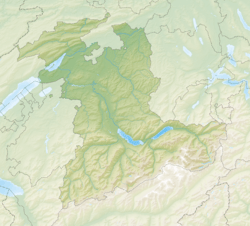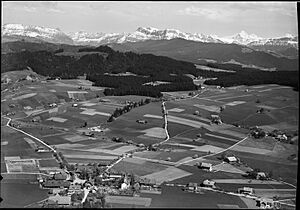Linden, Switzerland facts for kids
Quick facts for kids
Linden
|
||
|---|---|---|
|
||
| Country | Switzerland | |
| Canton | Bern | |
| District | Bern-Mittelland | |
| Area | ||
| • Total | 13.23 km2 (5.11 sq mi) | |
| Elevation | 916 m (3,005 ft) | |
| Population
(Dec 2020 )
|
||
| • Total | 1,304 | |
| • Density | 98.56/km2 (255.28/sq mi) | |
| Postal code |
3673
|
|
| Surrounded by | Aeschlen, Bowil, Buchholterberg, Freimettigen, Niederhünigen, Oberdiessbach, Oberhünigen, Röthenbach im Emmental | |
Linden is a small town, or municipality, in Switzerland. It is located in the Bern area, specifically in the Bern-Mittelland administrative district.
Contents
History of Linden
The municipality of Linden was created in 1945. Before that, it was made up of three separate towns: Ausserbirrmoos, Innerbirrmoos, and Otterbach. These three towns decided to join together to form one larger municipality.
Ausserbirrmoos: The Largest Part
Ausserbirrmoos was the biggest of the three towns that formed Linden. People first wrote about it in 1298, calling it Birmos. For many years, it was part of a larger area called the Herrschaft of Diessbach.
Ausserbirrmoos and Innerbirrmoos used to be one community. But in 1633, they split up and became independent towns. Later, in 1887, Ausserbirrmoos also took in the land and people from two smaller communities, Schöntal and Barschwand, when they stopped being separate towns. In 1941, before the big merger, about 466 people lived in Ausserbirrmoos.
Innerbirrmoos: A Farming Community
Innerbirrmoos was also mentioned in 1298, along with Ausserbirrmoos. Around 1399, it became part of the Bernese district of Röthenbach. Later, in 1529, it joined the Landvogtei of Signau.
This town separated from Ausserbirrmoos in 1633. For a long time, there were disagreements between farmers who owned land and those who worked on land they didn't own. They argued about how to use shared land. The city of Bern stepped in around 1778 to help them solve these problems. In 1941, Innerbirrmoos had 558 people. Even today, farming is still a very important part of life in this area.
Otterbach: The Smallest Part
Otterbach was first mentioned in 1236 as Ottirbach. Like Innerbirrmoos, it became part of the Bernese district of Röthenbach around 1399. Then, in 1529, it joined the Landvogtei of Signau.
Otterbach was the smallest and not as wealthy as the other two towns that joined to form Linden. In 1941, it had a population of 310 people.
The Hamlet of Linden and Its Church
The small village, or hamlet, called Linden was first mentioned in 1354. Even though it was right in the middle of the three towns, it was never an independent municipality itself.
All three towns – Ausserbirrmoos, Innerbirrmoos, and Otterbach – were part of the church area, or parish, of Oberdiessbach until 1860. That's when they decided to form their own parish called Kurzenberg. After the municipality of Linden was created in 1945, this became the parish of Linden. The main church for the parish was built in the hamlet of Linden in 1848. Since it was central, the local school was also built there.
Starting in the 1970s, the Swiss Army opened a training base in the area. Today, Linden is still a rural area with a lot of farming. However, about two-thirds of the people who live there travel to other towns for their jobs.
Geography
Linden covers an area of about 13.3 square kilometers (about 5.1 square miles). A large part of this land, about 60.5%, is used for farming. Forests cover about 32.8% of the area. The rest of the land is used for buildings and roads (6.3%), rivers or lakes (0.4%), or is unproductive (0.2%).
Linden doesn't have one main village center. Instead, it's made up of many scattered houses and small settlements. These are spread out on a low hill between the Aare River and Emme River.
In 2010, Linden became part of a new administrative area called Verwaltungskreis Bern-Mittelland.
Coat of Arms
The coat of arms for Linden shows a green linden tree growing from three green hills. Above the tree are three golden stars. The name "Linden" comes from the linden tree, so the tree on the coat of arms is a clever way to represent the town. This is called "canting arms" when the symbol on the shield sounds like the name of the place.
People of Linden (Demographics)
Linden has a population of about 1,299 people (as of 2018). In 2010, about 4.3% of the people living in Linden were from other countries. Over the past ten years (2001-2011), the number of people living in Linden has stayed pretty much the same.
Most people in Linden (about 96.6%) speak German as their main language. A smaller number speak French (1.9%) or English (0.2%).
In 2008, about 50.4% of the population was male and 49.6% was female. Most people in Linden were born either in Linden itself or somewhere else in the same canton (Bern).
In 2011, children and teenagers (ages 0-19) made up about 23.7% of the population. Adults (ages 20-64) made up 57.3%, and seniors (over 64) made up 19%.
Economy
In 2011, Linden had a very low unemployment rate of 0.48%. This means almost everyone who wanted a job had one.
In 2008, there were 541 people working in Linden.
- About 193 people worked in the primary sector, which mostly means farming. There were 72 businesses in this area.
- About 143 people worked in the secondary sector, which includes things like manufacturing (making goods) and construction (building things). There were 20 businesses in this area.
- About 205 people worked in the tertiary sector, which includes services like sales, transportation, hotels, education, and healthcare. There were 31 businesses in this area.
Many people who live in Linden travel to other towns for work. In 2000, 327 people left Linden for work, while only 91 came into Linden to work. Most people (51.3%) use a private car to get to work, while a smaller number (4.3%) use public transportation.
Religion
Based on information from 2000, most people in Linden (about 77.2%) belong to the Swiss Reformed Church. About 3.1% are Roman Catholic. There are also smaller numbers of people who belong to other Christian churches, or who are Islamic or Buddhist. About 11.9% of the population said they didn't belong to any church.
Education
In Linden, about 37.3% of the adults have finished high school (called "upper secondary education" in Switzerland). About 6% have gone on to higher education, like a university or a specialized college.
The school system in the Canton of Bern starts with one year of optional Kindergarten. After that, students go to six years of Primary school. Then, they have three years of lower Secondary school, where students are grouped by their abilities. After lower Secondary, students can choose to continue their schooling or start an apprenticeship to learn a trade.
During the 2010-2011 school year, 128 students attended schools in Linden. There was one kindergarten class with 14 students. There were five primary classes with 88 students. For lower secondary, there were two classes with 26 students.
Linden also has a library called Bibliothek Linden. In 2008, the library had 3,225 books and other items. It loaned out almost 3,000 items that year.
Images for kids
See also
 In Spanish: Linden (Suiza) para niños
In Spanish: Linden (Suiza) para niños





